How big is the universe - Study guides, Class notes & Summaries
Looking for the best study guides, study notes and summaries about How big is the universe? On this page you'll find 477 study documents about How big is the universe.
Page 4 out of 477 results
Sort by
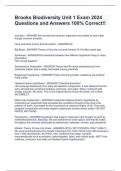
-
Brooks Biodiversity Unit 1 Exam 2024 Questions and Answers 100% Correct!!
- Exam (elaborations) • 10 pages • 2024
- Available in package deal
-
- $11.49
- + learn more
evolution - ANSWER-the concept that all given organisms are related to each other though common ancestry Have scientists proven that life exists? - ANSWER-No Big Bang - ANSWER-Theory of how the universe formed 16-18 billion years ago Symbiosis - ANSWER-the interaction between two different organisms living in close association "life coming together" Spontaneous Generation - ANSWER-Theory that life arose spontaneously from inanimate matter. Not a widely held belief among scientists...

-
ASTRONOMY CSCC EXAM 1 Questions And Answers Rated A+
- Exam (elaborations) • 6 pages • 2024
- Available in package deal
-
- $7.99
- + learn more
A chemoautotroph gets its energy from - chemical reactions and its carbon from its environment Abnormal forms of protein molecules called prions have one of the characteristics of living things in that they - actively respond to external changes According to Kepler's Second Law of planetary motion, a planet moves fastest in its orbit when it is - at perihelion According to the nebular theory for the formation of the solar system - planets should be rotating in the same direction as they o...
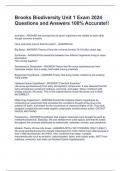
-
Brooks Biodiversity Unit 1 Exam 2024 Questions and Answers 100% Accurate!!
- Exam (elaborations) • 10 pages • 2024
- Available in package deal
-
- $11.49
- + learn more
Brooks Biodiversity Unit 1 Exam 2024 Questions and Answers 100% Accurate!! evolution - ANSWER-the concept that all given organisms are related to each other though common ancestry Have scientists proven that life exists? - ANSWER-No Big Bang - ANSWER-Theory of how the universe formed 16-18 billion years ago Symbiosis - ANSWER-the interaction between two different organisms living in close association "life coming together" Spontaneous Generation - ANSWER-Theory that life aros...

-
Brooks Biodiversity Unit 1 Exam Questions and Answers 100% Correct
- Exam (elaborations) • 15 pages • 2024
- Available in package deal
-
- $12.49
- + learn more
Brooks Biodiversity Unit 1 Exam Questions and Answers 100% Correct evolution - Answer- the concept that all given organisms are related to each other though common ancestry Have scientists proven that life exists? - Answer- No Big Bang - Answer- Theory of how the universe formed 16-18 billion years ago Symbiosis - Answer- the interaction between two different organisms living in close association "life coming together" Spontaneous Generation - Answer- Theory that life arose spontaneou...
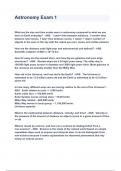
-
Astronomy Exam 1 Questions And Answers
- Exam (elaborations) • 8 pages • 2023
- Available in package deal
-
- $11.99
- + learn more
Astronomy Exam 1 Questions And Answers What are the size and time scales seen in astronomy compared to what we use here on Earth everyday? - ANS 1 year= time between solstices, 1 month= time between new moons, 1 day= time between noons, 1 week= 7 days= number of objects in the seen in the sky with the naked eye (sun, moon, and visible planets) How are the distance units light-year and astronomical unit defined? - ANS Scientific notation: 9.4607 x 10^12 km How far away are the neare...

-
Honors Biology FINAL Exam Questions and Answers 100% Correct
- Exam (elaborations) • 18 pages • 2024
-
- $12.49
- + learn more
Honors Biology FINAL Exam Questions and Answers 100% Correct Know the characteristics of prokaryotes vs. eukaryotes and the kingdoms that fall under each category. - Answer- prokaryotic - (single-celled, 3.5byo, smaller, no nucleus/membrane-bound organelles, Archaebacteria & Eubacteria) eukaryotic - (mostly multicellular (except for some protists), 1.5byo, larger, have nucleus and membrane-bound organelles, Plants, Fungi, Protists, Animals) What is a change in gene frequency of a populati...
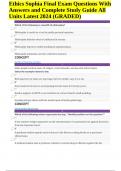
-
Ethics Sophia Final Exam Questions With Answers and Complete Study Guide All Units Latest 2024 (GRADED)
- Exam (elaborations) • 350 pages • 2024
-
- $15.49
- + learn more
Ethics Sophia Final Exam Questions With Answers and Complete Study Guide All Units Latest 2024 (GRADED) Many people confuse topics of religion, social etiquette, and law with ethical topics. Select the example related to law. • Beth approves of same-sex marriage, but her mother says it is a sin. • Don masks his income to avoid paying income taxes for twenty years. • Kendra neglects to RSVP to an invitation to a close friend’s small wedding. • Grandpa always chews with his mout...
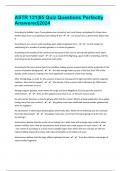
-
ASTR 121|85 Quiz Questions Perfectly Answered|2024
- Exam (elaborations) • 7 pages • 2024
-
- $8.49
- + learn more
According to Hubble's Law, if two galaxies are not part of our Local Group, and galaxy B is three times farther away from us as Galaxy A, then Galaxy B will - ️️ove away from us three times faster than A According to our current understanding, giant elliptical galaxies form: - ️️by the merger (or swallowing) of a number of smaller galaxies in a cluster of galaxies According to the models of the universe we discussed in this course, why do the galaxies move apart (why do we have Hubble...
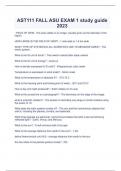
-
AST111 FALL ASU EXAM 1 study guide 2023
- Exam (elaborations) • 9 pages • 2023
-
- $11.49
- + learn more
- FIELD OF VIEW - The area visible in an image. Usually given as the diameter of the region. HOW LARGE IS THE FIELD OF VIEW? - 1 mile wide or 1.6 km wide WHAT TYPE OF SYSTEM DO ALL SCIENTISTS USE TO MEASURE SIZES? - The metric system. What is the SI unit of force? - The newton named after Isaac newton What is the SI unit of energy? - Joule (J) How is density expressed in Si units? - Kilograms per cubic meter Temperature is expressed on what scale? - Kelvin scale What is the ...

-
HMPYC80 Research Methodology (2022 - Semester 1 - Assignment 3)
- Exam (elaborations) • 14 pages • 2022
-
- $4.46
- 14x sold
- + learn more
HMPYC80 – Research Methodology 2022 – Semester 1 – Assignment 3 Question 1: Which of one of the following statements is NOT true about C-studies? C-studies research do NOT ... a) aim to explore or describe without statistical testing and typically use non-random or purposive sampling (NR). b) compare groups or examine relationships between variables by means of some form of statistical hypothesis testing. c) aim to explain phenomena by means of a hypothesis. d) use random sampli...

Did you know that on average a seller on Stuvia earns $82 per month selling study resources? Hmm, hint, hint. Discover all about earning on Stuvia


